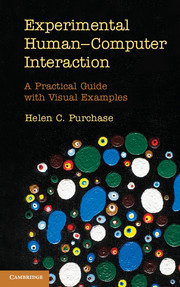Book contents
- Frontmatter
- Contents
- List of experiments
- Acknowledgements
- Preface
- 1 Introduction
- 2 Defining the research
- 3 Experimental procedure
- 4 Data collection and qualitative analysis
- 5 Statistics
- 6 Reporting
- 7 Problems and pitfalls
- 8 Six principles for conducting experiments
- Appendix A1 Independent measures examples
- Appendix A2 Statistical formulae
- Appendix A3 Factor analysis example
- Bibliography
- References
- Index
8 - Six principles for conducting experiments
Published online by Cambridge University Press: 05 August 2012
- Frontmatter
- Contents
- List of experiments
- Acknowledgements
- Preface
- 1 Introduction
- 2 Defining the research
- 3 Experimental procedure
- 4 Data collection and qualitative analysis
- 5 Statistics
- 6 Reporting
- 7 Problems and pitfalls
- 8 Six principles for conducting experiments
- Appendix A1 Independent measures examples
- Appendix A2 Statistical formulae
- Appendix A3 Factor analysis example
- Bibliography
- References
- Index
Summary
To conclude, this chapter summarises the contents of this book by presenting amodel and six key principles for designing and conducting experiments.
A model of the experimental process
The model, presented in Figure 8.1, shows the main stages of the experimentalprocess and the important considerations that need to be addressed at eachstage.
Six key principles for conducting experiments
This book presents specific advice to guide the researcher through theexperimental process, and, subsequently, six key general principles emerge.These are listed as follows:
Principle 1: Define a clear research question and answer it.Doing so will provide a useful focus throughout the process and will ensurethat a good “story” can be told at the end. Many decisionsneed to be made, and making them within the context of a clearly phrasedresearch question will make them easier to decide on and justify.
Principle 2: Plan, prepare, and pilot. Participant time is ascarce resource: insufficient preparation will simply result in wasting theparticipants’ time. You cannot do too much preparation!
Principle 3: Only collect, analyse, and present data that aremeaningful to the research question. Experimenter time is also ascarce resource. Like Principle 1, this principle ensures that your effortsare focussed, that you are not sidetracked into addressing interesting (butirrelevant) issues, and that your own time is not wasted.
Principle 4: Apply the planned analysis method on fabricated databefore running the experiment. Collecting data that are notsufficient for answering your research question wastes your time and theparticipants’ time. Identify the form of data required for answering theresearch question before you start the experiment.
Principle 5: Collect and use both quantitative and qualitativedata. The temptation is to focus on the numbers, whereas “softer”data are often much more revealing. Qualitative data are also useful whenthe numbers do not tell you what you wanted to hear.
Principle 6: Acknowledge the limitations of the experiment.Doing so is not only honest, but ensures that you do not overstate theconclusions. It also helps preempt the criticisms of reviewers.
Information
- Type
- Chapter
- Information
- Experimental Human-Computer InteractionA Practical Guide with Visual Examples, pp. 199 - 202Publisher: Cambridge University PressPrint publication year: 2012
